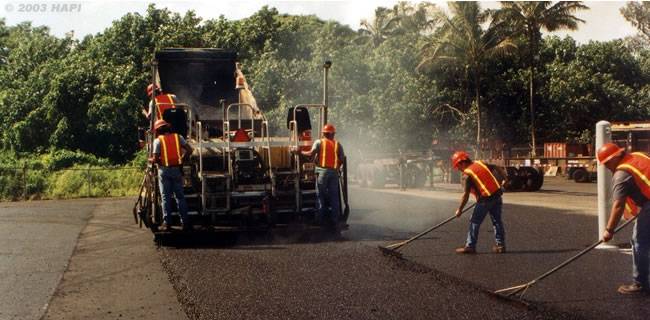HMA Mix Types
The most common type of flexible pavement surfacing in the U.S. is hot mix asphalt (HMA). Hot mix asphalt is known by many different names such as hot mix, asphalt concrete (AC or ACP), asphalt, blacktop or bitumen. For clarity, this Guide makes a conscious effort to consistently refer to this material as HMA. HMA is distinguished by its design and production methods (as described in this Guide) and includes traditional dense-graded mixes as well as stone matrix asphalt (SMA) and various open-graded HMAs. Warm mix aspshalt (WMA) is a variant of HMA that is produced at lower temperatures. Typically agencies consider other types of asphalt-based pavement surfaces such as fog seals, slurry seals and chip seals to be maintenance treatments and are therefore covered in the Maintenance & Rehabilitation section. Reclaimed asphalt pavement (RAP) is generally considered a material within HMA, while forms of in-place recycling are considered separately.
Dense-Graded Mixes
A dense-graded mix is a well-graded HMA intended for general use. When properly designed and constructed, a dense-graded mix is relatively impermeable. Dense-graded mixes are generally referred to by their nominal maximum aggregate size and can further be classified as either fine-graded or coarse-graded. Fine-graded mixes have more fine and sand sized particles than coarse-graded mixes. Dense-graded mixes are used extensively in Hawai'i for all purposes.
| Figure 1: Dense-graded HMA cut-away view. | Figure 2: Dense-graded cores. |
Purpose. Suitable for all pavement layers and for all traffic conditions. Works well for structural, friction, leveling and patching needs.
Materials. Well-graded aggregate, asphalt binder (with or without modifiers), RAP
Information. Particulars about dense-graded HMA are covered by the rest of this Guide.
Stone Matrix Asphalt (SMA)
Stone matrix asphalt (SMA), sometimes called stone mastic asphalt, is a gap-graded HMA originally developed in Europe to maximize rutting resistance and durability. The mix design goal is to create stone-on-stone contact within the mixture. Since aggregates do not deform as much as asphalt binder under load, this stone-on-stone contact greatly reduces rutting. SMA is generally more expensive than a typical dense-graded HMA because it requires more durable aggregates, more aggregate stockpiles (and sometimes more waste in creating the gradation from available stockpiles), higher asphalt content, modified asphalt binder and fibers. In the right situations it is cost-effective because of its increased rut resistance and improved durability. SMA, has been used with success in the U.S. since about 1990.
| Figure 3: SMA cut-away view. | Figure 4: SMA lab sample. |
Purpose. Improved rut resistance and durability. SMA is almost exclusively used for surface courses on high volume interstates and U.S. roads.
Materials. Gap-graded aggregate, modified asphalt binder, fiber filler
Information. Other reported SMA benefits include wet weather friction (due to a coarser surface texture), lower tire noise (due to a coarser surface texture) and less severe reflective cracking. Mineral fillers and additives are used to minimize asphalt binder drain-down during construction, increase the amount of asphalt binder used in the mix and to improve mix durability.
| HAPI Pavement Note on Stone Matrix Asphalt |
The State of Hawai'i has done two SMA trial projects: one on the Big Island at Hilo Harbor in 2001, and one on the Moanalua Freeway in 2004. To date both are holding up well.
Figure 5: Placing SMA at Hilo Harbor. |
Open-Graded Mixes
Unlike dense-graded mixes and SMA, an open-graded HMA mixture is designed to be water permeable. Open-graded mixes use only crushed stone (or gravel) and a small percentage of manufactured sands. The three most typical uses for open-graded mixes are:
- Open-graded friction course (OGFC). A thin surfacing layer used to improve safety by (1) improving visibility from reduced tire splash and spray in wet weather, (2) reducing hydroplaning risk by reducing water sheet flow across the pavement surface in wet weather, and (3) improved skid resistance.
- Permeable pavement. An entire pavement structure that is designed to allow water to pass through the pavement. Usually the goal is to allow the water to infiltrate into the ground underneath the pavement. Permeable pavement is a commonly used low impact development (LID) technique.
- Asphalt treated permeable bases (ATPB). A pavement base layer sometimes used under dense-graded HMA, SMA or portland cement concrete to assist in drainage.
| HAPI Pavement Note on Open-Graded Mixes |
Open-graded friction courses (OGFCs) are not typically used by either the Hawai'i Department of Transportation (HDOT) or the Counties. HDOT does have a specification for ATPB, but it is rarely used. HDOT does use an open-graded untreated aggregate material for drainage purposes. The Office of Federal Lands Highway (FLH) and National Park Service recently (Summer 2012) used an OGFC for portions of Volcanoes National Park in an effort to improve tire-pavement friction. Figure 5: Placing OGFC on Chain of Craters Road, Volcanoes National Park. |
| Figure 6: OGFC surface close up. | Figure 7: OGFC lab samples. |
Purpose. OGFCs are used as surface courses only. They are used to improve safety by (1) improving visibility from reduced tire splash and spray in wet weather, (2) reducing hydroplaning risk by reducing water sheet flow across the pavement surface in wet weather, and (3) improved skid resistance. They can also reduce tire-pavement noise resulting in reduced road noise in some situations. Porous pavements are typically used as a LID solution designed to (1) reduce the total impervious surface area of a project, (2) to aid in increasing stormwater infiltration into the ground, and (3) reduce the amount and, potentially, cost of the required stormwater infrastructure associated with a project or area. ATPB is usually included as a base layer to improve drainage of that layer and prevent water from accumulating underneath and weakening the overlying pavement
Materials. Aggregate (crushed stone or gravel and manufactured sands), asphalt binder (with modifiers).
Information. Open-graded mixes are usually more expensive per ton than dense-graded HMA, but the unit weight of the mix when in-place is lower, which partially offsets the higher per-ton cost. The open gradation creates pores in the mix, which are essential to the mix's proper function. Anything that tends to clog these pores, such as excessive dirt on the roadway can degrade performance.



